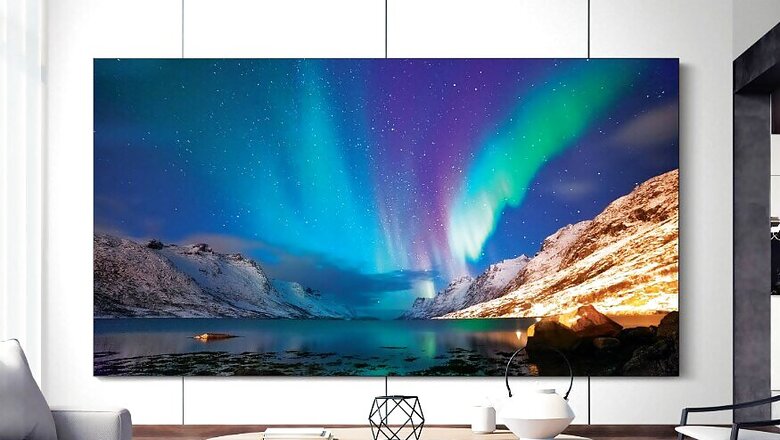
views
Samsung has had a grand showing last night at CES 2020, with its First Look event showing off what the world's largest television maker has in mind for televisions in 2020. This year, Samsung is going all out for the fantastic, showing off new TV technologies with barely a hint of a bezel, more screen sizes for The Wall lineup that expand the largest seen TV size up to 292 inches and even include producing 8K resolution playback for 150-inch TVs, an automatically rotating TV that matches the orientation of videos playing on your phone, and more. With this in mind, here's looking at what Samsung has in store for its televisions of 2020.
No bezels
The talk of the town is, undoubtedly, Samsung's new, ultra-slim infinity design language. The technology in question comes with Samsung's Q950TS flagship television, which now sits at the very top of the pile for 2020. The TV uses Samsung's microLED technology that was unveiled in CES 2019, to present a television that has a 99 percent all-screen front. According to a report by Cnet, the TV does have some bezel or frame around it, but at just 2.3mm on a screen as massive as 88 inches, that is barely visible. The result is a stunning visual element that makes the TV appear like a floating piece of glass. With 8K native resolution, there is no chance that this TV will be "affordable" by any means. Samsung has not unveiled an availability date or even a price tag for the Samsung Q950TS 8K microLED infinity television, which may well be its official name on the marketing brochures.
More 8K, more AI
Along with the infinity display design, Samsung is also expanding on its 8K TV reservoir. Along with the 75-inch 4K TV that may be the very first attempt at a (relatively) affordable microLED TV, Samsung now offers 8K TVs in 88-inch, 93-inch, 110-inch and 150-inch sizes. The technology is based on the Samsung AI Quantum Processor 8K, which offers a built-in 8K AI upscaling engine with deep learning algos, which Samsung claims will seamlessly upscale content to 8K, and Samsung's official release mentions YouTube content creators as one group that would largely benefit from this. Samsung's AI additions to its TVs now include something called 'Adaptive Picture', which it states will automatically gauge the ambiance of a room and "optimise the screen to both ambient conditions and individual images". This is further supplemented by a "premium" sound feature, Q Symphony, which Samsung says will combine the sound from its native TV speakers along with external soundbars to deliver "dimensional and dynamic" audio based on the on-screen visuals.
Screens as large as 292 inches
The company also took this opportunity to show the world how modular its microLED technology really is. The result is a new product in its 'The Wall' lineup that measures an insane 292 inches in diagonal width. It is unlikely that Samsung will find too many takers for it — even if you have the money, which will presumably be a LOT, you still need a gigantic room where this TV will look appropriate. This, though, is not about sales figures — the 292-inch The Wall TV is all about showing how modular microLED technology is, and how this can become mainstream in future.
A 'Portrait' TV
Samsung also unveiled 'The Sero', and its big party trick is to match your daughter's video cravings on TikTok. The Sero features a mount that comes with a motorised hinge, which can turn from landscape to portrait orientation at the touch of a remote button. It can also flip around automatically if you sync it to your phone, giving you a seamless usage experience, and essentially, a massive smartphone screen mirroring tool that you can watch viral video content on.
Privacy Choices
The last in the line of announcements came in the form of a new privacy app for Samsung's smart TVs, called Samsung Privacy Choices. While the app has not been launched yet, Samsung has stated that its app will give the onus of privacy back to the user. The Privacy Choices app will help users see what data is their TV collecting, and what all are being shared with third party service providers. Apparently, users will also have the ability to prevent the TV from doing so. The app should feature in future Samsung TV firmware, and is admittedly the least glamorous announcement of the lot.



















Comments
0 comment